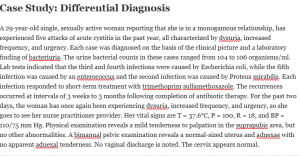Case Study: Differential Diagnosis

A 29-year-old single, sexually active woman reporting that she is in a monogamous relationship, has experienced five attacks of acute cystitis in the past year, all characterized by dysuria, increased frequency, and urgency. Each case was diagnosed on the basis of the clinical picture and a laboratory finding of bacteriuria. The urine bacterial counts in these cases ranged from 104 to 106 organisms/ml. Lab tests indicated that the third and fourth infections were caused by Escherichia coli, while the fifth infection was caused by an enterococcus and the second infection was caused by Proteus mirabilis. Each infection responded to short-term treatment with trimethoprim sulfamethoxazole. The recurrences occurred at intervals of 3 weeks to 3 months following completion of antibiotic therapy. For the past two days, the woman has once again been experiencing dysuria, increased frequency, and urgency, so she goes to see her nurse practitioner provider. Her vital signs are T = 37.6°C, P = 100, R = 18, and BP = 110/75 mm Hg. Physical examination reveals a mild tenderness to palpation in the suprapubic area, but no other abnormalities. A bimanual pelvic examination reveals a normal-sized uterus and adnexae with no apparent adnexal tenderness. No vaginal discharge is noted. The cervix appears normal.
Questions:
- What is the differential diagnosis for this set of symptoms? What is your preliminary diagnosis?
- What tests should you order to confirm your preliminary diagnosis?
- What are the possible causes of recurrent lower UTIs? Which of these is most likely in this case?
- When would you collaborate with other professionals and refer your patient to a specialist and why?
Please support with up-to-date evidence-based standard of care guidelines.
Please read the case study and answer the